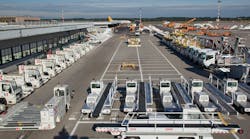A Norwegian Air plane that aborted an international flight spewed a substantial amount of fuel on a large area of Orlando International Airport during its emergency landing, which an aviation expert described as a rare and potentially dangerous occurrence.
The incident happened late Saturday night, triggered initially by warnings of a failed hydraulic pump. Federal authorities have since begun an investigation while airport officials are assessing costs for cleaning up runway and taxiway surfaces.
The Norwegian flight, using a 19-year-old leased aircraft, was well out across the Atlantic Ocean when it reversed course and returned to Florida. Passengers were on board for nearly five hours, or more than half the time they would otherwise have spent on a flight to London’s Gatwick airport.
The returning flight was met by emergency vehicles, and passengers were held on the plane for an hour. Portions of the airport tarmac were closed temporarily so that crews could remove the spilled fuel.
Judy Watson Tracy was on that flight and from a window on the plane’s right side photographed a fountain of jet fuel coming from the rear edge of the wing to the runway.
Charles Westbrooks, aeronautical science professor at Embry-Riddle Aeronautical University and a former airline pilot, said most pilots never experience having to dump fuel. Far more rare is spilling fuel at an airport, he said.
“It would not be done intentionally,” Westbrooks said. “I can think of no reason why anyone would do that on purpose.”
Neither Norwegian nor the company providing the leased Airbus 340 for the London flight, Hi-Fly of Portugal, would explain why the wide-body aircraft dumped fuel on the airport’s runways and taxiways.
“As a standard safety practice, fuel was dumped prior to the safe landing of the aircraft at MCO, however there may have been some residual leakage from its wings,” Norwegian spokeswoman Min Kim said.
A HiFly spokeswoman said there was “no emergency situation” from a hydraulic pump’s “malfunction indication.”
“The aircraft was on the initial phase for a long haul flight to Europe so fuel had to be dumped to bring the aircraft into adequate landing weight,” Inês Pompeu dos Santos said.
The Federal Aviation Administration, confirming that it is investigating the aborted flight, said in a statement the “Norwegian Air 7058, Airbus A343, landed safely at Orlando International Airport at 9:53 p.m., June 29, after the pilot reported a loss of the aircraft’s primary hydraulic system.”
Westbrooks said a plane such as the HiFly Airbus would dump as much as 30,000 gallons of jet fuel in order to shed weight for a safe landing.
Pilots try to dump fuel over water if possible or over a rural area. With the plane traveling at several hundred miles per hour, dumped fuel quickly atomizes into a fine mist or vapor.
Dumping it on a runway is another matter, Westbrooks said, especially if it accumulates beneath the plane.
“You potentially have 200 or 250 people sitting on top of a flammable substance and the engines are running,” Westbrooks said. “I would not be comfortable with that at all.”
Orlando airport authorities said the amounts of fuel dumped on runways and taxiways of the airport’s west side “are still being determined but was of significant size.”
They said airport leaders are unaware of such an incident occurring previously.
Contractors were called in for a cleanup and costs have not yet been determined, airport officials said.
The website FlightAware shows the airplane reached an altitude of 35,000 feet and was east of North Carolina’s coast when it turned back to Orlando.
As the Airbus neared Florida’s coast at Daytona Beach, it completed four, large circles while still over water, and then flew to Orlando International Airport.
Not clear is whether the aircraft was dumping fuel over the Orlando metro area as it approached the airport.
Norwegian began to alert passengers earlier this year that it was relying on leased aircraft that are older than the airline’s newer Boeing 787 airplanes, which reportedly are in need of engine maintenance.
“We are contacting you to inform you that your flight will be operated by another Carrier,” Norwegian Air said in a statement. "We understand that these changes are not ideal, but it was necessary for us to lease an aircraft from another Carrier in order to avoid a disruption to your flight
———
©2019 The Orlando Sentinel (Orlando, Fla.)
Visit The Orlando Sentinel (Orlando, Fla.) at www.OrlandoSentinel.com
Distributed by Tribune Content Agency, LLC.

